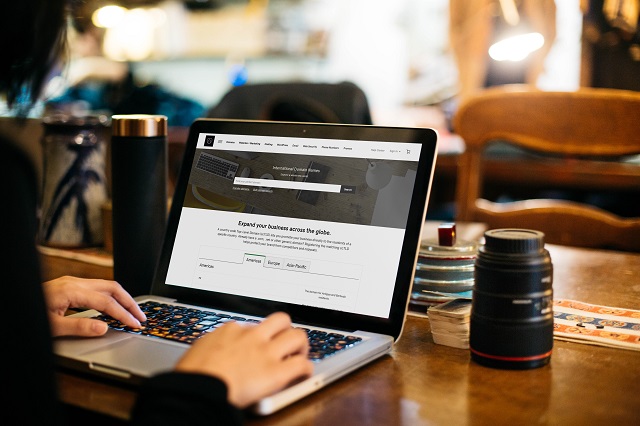If you’re an entrepreneur with an online business, you know there could be thousands – maybe even millions – of people in other countries who may be interested in your products or services. In this article, you’ll learn how to use country-specific domain names, giving you and your business a presence and profile in other countries in a relatively easy and inexpensive manner.
Using country-specific domain names to expand your global footprint
Domain names play an important technical role related to websites and email, but domain names can also be powerful, strategic tools for entrepreneurs to use. One way to do so is to use domains is in a globally proactive manner, and by that, I mean using domains to help grow your business around the world.
How? Start by acquiring country-specific domain names to expand your global footprint and reach.
- What are country-specific domain names?
- Advantages of using ccTLDs.
- How to develop your ccTLD domain plan.
- Where and how to register country-specific domain names.
- Important factors to know about ccTLDs.
- Remember international spelling and lingo.
- Think global. Act promptly.
What are country-specific domain names?
A ccTLD (Country Code Top-level Domain) is a two-letter domain extension used primarily to identify an association of some kind to a specific country or territory. There are approximately 300 ccTLDs, with over 150 million domains registered using one of them.
The five most popular ccTLDs are .cn (China), .tk (Tokelau), .de (Germany), .uk (United Kingdom), and .tw (Taiwan).
Fun fact: The United States of America has its own ccTLD, .us, but that ccTLD has never gained much traction despite being around since 1985. In many ways, .com has become America’s unofficial ccTLD due to the popularity of .com and its long-time association with American companies.
Although there are 300+ ccTLDs associated with most (but not all) of the countries in the world, many internet users don’t frequently encounter these domains in their everyday activities. And what you will encounter in terms of ccTLDs varies dramatically based on the country you’re living in at the time.
If you’re based in the United States, you’re probably used to seeing lots of .com domains, with the occasional .net and .orgpopping up from time to time, and maybe even the occasional .ca domain from your neighbors in Canada.
But if you’re based in Italy, you’re used to seeing lots of .it domains, with a tiny dash of .com domains thrown in for variety. In Germany, they are huge fans and users of the .de domain, and in Japan, everywhere you look you are going to see .jpdomains.

Some countries are fiercely loyal to their ccTLD domains, and their use is a source of national pride. It’s almost as if their ccTLD domain is waving a flag saying, “look at me, I’m a website from your country.”
Today, people in many countries have grown up being told to expect to find local websites using their country’s ccTLD, so if you hope to do business with those people, it will be to your advantage to own the relevant ccTLD version of your company’s domain name.
If your company name is Acme, and you’re based in the United States, then you probably — and hopefully — already own acme.com, since that is what Americans would expect your domain name to be. But if you plan on doing business in France, for instance, you will want to secure acme.fr because that is where the French will expect to find your company and your website.
Related: Domains: The foundation to internet security, speed and reliability
Advantages of using ccTLDs
Using a country-specific domain name can also be advantageous from an SEO perspective.
Google, for example, gives preference within its search results within the matching country to websites using the local ccTLD. A search for “tapas” within Spain using the localized (Spanish) version of Google, will often give preference to the local “tapas” websites that use a .es (Spain) domain name.
There’s also an important psychological factor at play here.
If you’re a Brazilian living in Rio de Janeiro and you’re presented with the choice of transacting with an online store that uses your country’s .br ccTLD, versus a foreign ccTLD, you might feel more comfortable doing business with the website using the TLD that is most familiar to you.
How to develop your ccTLD domain plan
For the everyday entrepreneur who is thinking globally, no matter what country you are in, you need to develop a plan for your country-specific domain names.
With hundreds of countries in the world, this may sound like a daunting task at first. Don’t worry — it doesn’t have to be.
Start by asking yourself which countries you hope to do business in during the next 12 to 24 months. Approach your plans for world domination in baby steps.
You don’t have to go out and try to register every single country domain name, and quite frankly you probably shouldn’t. That is likely to be overkill, costly and difficult to manage.
There are three approaches you can take when prioritizing ccTLDs: thinking of the specific countries you hope to expand your business into, or focusing on certain regions or continents, or focusing on countries that do business in the same language that you do.
No matter how you choose to prioritize, your goal is to end up with a prioritized list of countries where you hope to acquire the matching country-specific domain name.
Related: How to start building a strong domain name portfolio
Where and how to register country-specific domain names

Once you’ve identified the priority country or countries for your ccTLD domain wishlist, be proactive in terms of registering or acquiring those domain names. Trust me when I say this, it is much cheaper to be proactive.
Let’s use the example of a .se (Sweden) domain. If you’re contemplating expanding your business globally into Sweden, it’s much better to register acme.se today and pay $27, while the domain is still available to register, than have to pay a third party hundreds or even thousands of dollars for that domain a year or two from now because they beat you to it.
One thing to keep in mind is that for some of these ccTLDs, there may be special registration, ownership and usage requirements.
For example, Canada’s .ca domains require the owner to be a verifiable Canadian citizen or organization.
For China’s .cn domains, non-Chinese citizens can register them, however, a license from the Chinese government is required to put the domain to use for a website.
Germany’s .de domain, on the other hand, has no such restrictions and is available for anyone and everyone to register and use.
Each country has its own specific ccTLD registration rules, and some are strict, and some are relaxed. You will want to check with your domain registrar first to find out what process or paperwork is required in order to get the specific ccTLD domain.
While at first you may feel frustrated that a specific ccTLD is more difficult to register than another country’s, there are some unexpected advantages to this.
For one thing, if it will be trickier for you to register this domain name, it will also be trickier for another party that has less than ideal motives to do the same. This can serve as a natural deterrent to anyone wanting to deliberately interfere with your rightful registration of the country-specific domain name you had in mind.
Another advantage to these ccTLDs is that because their registration is more strictly regulated by their host country, the residents of that country may attribute greater trust to the companies that are successful in registering those domain names.
Now you can see how this can cut both ways and be a good thing for you.
Want to see if the domain you had in mind is available? Give it a try here:
Important factors to know about ccTLDs
In some countries, they use second-level versions of their ccTLD to signify different types of businesses and website usage.
In Australia, for example, .com.au and .org.au are available, with the latter more suitable for use by charities and not-for-profit organizations.
In cases like this, you will need to think about which second-level version of the particular ccTLD is appropriate for the type of business you operate. If you’re not sure which version of the ccTLD to register, speak with a savvy local in that country and/or ask your domain registrar for their advice.
You should also be aware that a small percentage of ccTLDs have been repurposed by their host countries for global use by anyone as international domain names. There are some ccTLDs that are no longer viewed as country-specific domains.
Some examples of these ccTLDs that now have a different meaning are .tv (Tuvalu), .me (Montenegro), .co (Colombia), and .io (British Indian Ocean Territory). The latter two are especially popular these days with startups around the world as alternatives to .com domains.
If the domain registrar you use doesn’t offer registration of the specific ccTLD you hope to get, ask your registrar to recommend a ccTLD specialist registrar that does.
There are some domain registrars that focus on the more obscure and tricky-to-register ccTLDs, and in some cases, the only way to register a ccTLD is directly from the operator of that country-specific domain name.
Related: The ultimate guide to the best eCommerce domain names
Remember international spelling and lingo
One related aspect of going global using domain names is to think about international spelling and lingo. In addition to there being many different languages in the world, even people that speak the same language don’t always spell words the same way.
If you’re in the United States and your domain name is acmecolor.com, remember, that customers in Canada and the UK spell color with a “u.” So in a perfect world, you would want to get “acmecolour” versions of the desired domain names.
Some countries also use different terms for the same item. If you’re in the elevator business and your domain name is acmeelevators.com, make sure you also have “acmelifts” domains because in the UK, they refer to elevators as “lifts.”
Think global. Act promptly.

If you plan to do business beyond your current country, take a proactive approach to your global domain name strategy.
Develop your prioritized ccTLD domain wishlist sooner rather than later, and then acquire your country code names while you still can.
There is more to doing business in another country than just having the ideal ccTLD domain name, but getting that domain name is an important first step.
Once you’ve secured the domain name, you will also need to translate your website content into the local language, make sure you understand and follow the business rules of that country, provide customer support in that country’s language and time zones, and be sensitive to the cultural nuances of doing business in that country.
Don’t feel overwhelmed. You don’t necessarily have to launch an all-new Japanese version of your website to point the domains to. There are a number of ways you can put those domain names to work for you almost immediately.
One option is to point the domains to your existing website’s home page, although this is not the ideal interim solution. It would be better to point the domain to a sub-page on your website that is written in either the language of that country or at least references that country in an appropriate manner.
Either way, you can probably use your new country-specific domain names right away. By doing so, you’re beginning to demonstrate to people in those countries that you’re thinking globally and open to doing business with them.
Welcome to the world stage.
The post Expand your company’s global reach by using country-specific domain names appeared first on GoDaddy Blog.







